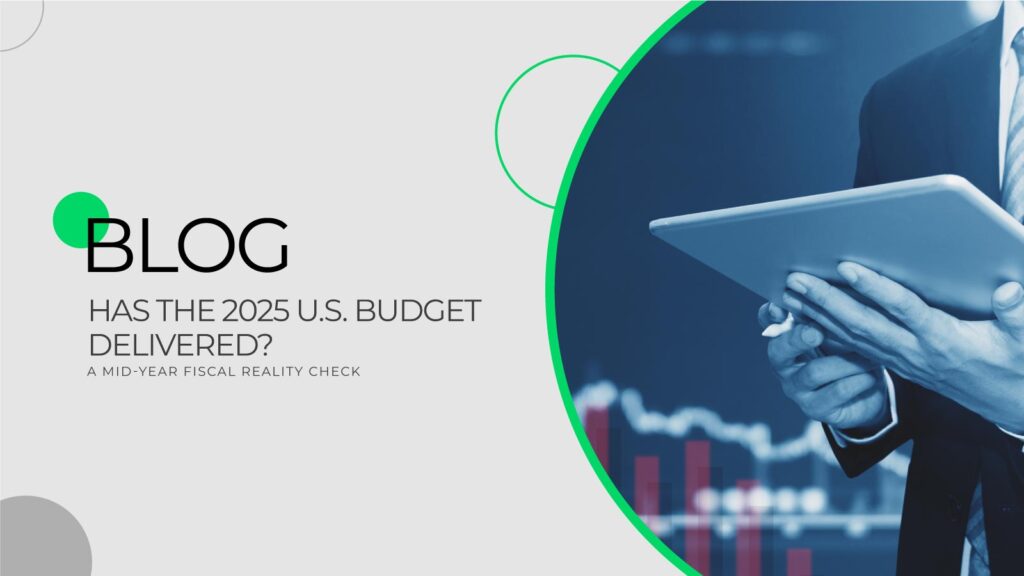It’s critical to assess the efficiency of the U.S. Budget and its effects on the fintech industry as we approach the halfway point in 2025. This year’s fiscal policies have significantly impacted economic growth, technological innovation, and regulatory landscapes. This analysis gives fintech professionals insights into how these developments influence the industry.
The 2025 Fiscal Report Under Review
By mid-2025, fintech professionals and financial leaders will be actively assessing how the current federal U.S. budget is performing. Economic resilience, innovation funding, and compliance standards all reflect the ways the 2025 U.S. budget is shaping the broader financial ecosystem.
As per the U.S. Government Publishing Office, the U.S. budget for this year is aimed at sustaining fiscal restraint while supporting inclusive economic growth. But has it been provided? This assessment analyzes the economic measures, strategies for innovation, fintech-specific rules, and funding dynamics that characterize the present fiscal path.
U.S. Budget Effects on Economic Performance and Revenue Management
The Congressional Budget Office (CBO) predicted that the government’s deficit would reach $1.1 trillion through May 2025 for the start of this fiscal year. This is higher than the $781 billion deficit during the same time last year. Government spending has gone up by 13%, but income has only increased by 2%. This puts a lot of pressure on the U.S. budget. Fintech leaders are worried about this because they need a stable economy to plan investments and understand how much consumers will spend.
The 2025 U.S. budget continues to focus on important areas like infrastructure, defense, health, and dealing with climate change. However, it also includes record-high government spending on debt payments because interest rates are rising. The long-term goal is to reduce deficits by nearly $3 trillion over the next ten years. The main ways to do this are through proposed tax changes and closing loopholes. For people in the fintech industry, this suggests that there will be tight financial conditions, which could affect credit markets and the amount of money available.
Inflation remains a big problem. Even though predictions say it will drop to 2.5% in the last three months of the year, it is currently at 3.1%. This is increasing the costs for businesses to operate and reducing the amount of cash consumers have. However, predictions for GDP growth remain steady at 2.25%, and the job market is strong, with unemployment staying at 3.9%. This supports a somewhat positive outlook for economic growth.
Strategic Investments in Technology and Fintech Opportunities
The 2025 budget doubles down on the Biden administration’s agenda to raise public investment in tech innovation. The Department of Commerce was awarded more than $11.4 billion in discretionary spending to support American competitiveness, plus $4 billion in mandatory appropriations earmarked for chip production, AI research, and quantum computing.
This signals critical partnership potential for fintech firms involved in AI, blockchain, and cloud infrastructure. The budget also earmarks substantial funds for upgrading digital infrastructure across federal agencies, including the IRS, Securities and Exchange Commission (SEC), and SBA, with an emphasis on automation, cybersecurity, and system modernization.
Extra money to the SEC will enable the agency to increase its cyber and financial crime units as well as tighten regulation of digital asset markets. For fintech firms, it is an opportunity and challenge: those that deal in RegTech and compliance automation solutions might see increasing demand, while others in underserved regions will see increasing regulation.
Fintech Regulation and Evolving Compliance Requirements
In 2025, fintech companies are adapting to a quickly changing regulatory landscape. The Consumer Financial Protection Bureau’s broadening authority, as well as the refunding of the Financial Crimes Enforcement Network (FinCEN), reflect the administration’s desire to expand transparency, accountability, and data protection.
Though the U.S. has yet to implement the Consumer Data Right (CDR), which Australia and other nations have already done, the CDR entered federal-level dialogue. Open banking continues to dominate the agenda, but the 2025 budget keeps a relatively hardline approach in committing limited finances to its activation. For fintechs focused on API-based service delivery and data aggregation, this regulatory hesitation may delay widespread open finance adoption.
However, updates to AML and KYC obligations under the Bank Secrecy Act have introduced tougher reporting standards and broadened the scope of fintech firms that fall under regulatory purview. Financial service providers must now account for cross-border data sharing, enhanced beneficial ownership tracking, and AI-model transparency.
Market Growth, Investment Shifts, and Financial Infrastructure
Despite rising deficits, fintech investment is climbing. Global fintech funding reached $8.5 billion in Q1 2025, a 12% jump over the previous quarter. Digital identity platforms, embedded banking, RegTech, and payment innovation have all benefited greatly from that investment. With an annual growth rate of 6.1%, Forrester projects that U.S. IT spending will reach $2.7 trillion by 2025.
This aligns with trends from Plaid and Dashdevs, showing that fintech is evolving rapidly in sectors like AI-enabled fraud prevention (projected to grow to $15.64 billion by end-2025), digital wallets, and decentralized finance (DeFi).
Payment systems in real time, backed by FedNow as well as proprietary networks, also came of age in 2025. Smaller and medium-sized business usage has picked up pace, bettering liquidity forecasts and lessening credit risk. Fintech vendors providing orchestration of payment, B2B integration, or working capital analytics have ridden the wave.
Further, the increased IRS modernization and improved tax compliance enforcement are helping tax fintechs find growth. AI-powered tax preparation, as well as robotic audit readiness offerings, are becoming part of the fabric in financial back-office settings such as SMBs and solo pros.
What Fintech Leaders Should Know from the 2025 Budget Mid-Year Review
Budget Execution Is Mixed
Tax revenues have continued to be solid thanks to IRS enforcement and a stable jobs base, but discretionary spending, particularly in infrastructure and clean energy, is slower than expected. Fintech companies that monitor fiscal flows should keep an eye on 3rd and 4th Quarter reports to gauge when the funding will become fully realized.
Deficit Reduction is Still the Priority
The Treasury’s revised estimates indicate a lower-than-anticipated deficit, thanks to higher personal and company tax revenues. This budgetary restraint can affect future interest rate expectations, particularly if the government continues to cut its dependence on short-term debt instruments.
Digital Infrastructure and AI Investments Are Real but Uneven
The FY2025 budget prioritized AI and quantum research, but disbursement is delayed. Fintechs focused on digital ID, privacy tech, or AI auditing should expect late 2025 RFP surges.
Regulatory Expansion Is Underway
Financial regulation agencies such as the CFPB and SEC have been given mid-year funding increases. Look for new compliance mandates for data transparency and algorithmic fairness by early 2026.
Fintech Opportunity Zones
The Treasury is bringing back Qualified Opportunity Zones and tax credits for technology. Fintechs who have solutions to small business lending and real-time tax administration might gain from purposeful incentives during the 4th Quarter.
FAQs
1. What are the key fintech-related investments in the 2025 federal U.S. budget?
The 2025 budget prioritizes AI, quantum computing, digital infrastructure, and cybersecurity. Over $11.4 billion in discretionary funding and $4 billion in mandatory appropriations support innovation, particularly across agencies like the SEC, IRS, and SBA. These investments signal new opportunities for fintechs involved in regtech, AI auditing, tax tech, and compliance automation.
2. How does the 2025 U.S. budget affect fintech compliance and regulatory requirements?
The budget expands funding for oversight agencies like the SEC, CFPB, and FinCEN. It introduces stricter reporting under AML/KYC rules, emphasizes beneficial ownership transparency, and supports AI model governance. Fintechs must prepare for enhanced scrutiny, especially those in payments, digital assets, and cross-border services.
3. Is open banking part of the 2025 federal U.S. budget agenda?
Open banking remains a federal discussion point, but the 2025 budget does not allocate major funding for it. While consumer data rights and API-based financial services are evolving, full-scale adoption in the U.S. remains limited. Fintech companies should monitor upcoming legislative sessions and regulatory rulemaking in 2026.
4. How does inflation and the federal deficit in 2025 impact fintech markets and investment?
With inflation hovering around 3.1% and a $1.1 trillion deficit in mid-2025, economic uncertainty persists. However, fintech investment remains strong, particularly in payments, fraud detection, and DeFi. Firms should anticipate tighter liquidity in some sectors, but also strategic funding opportunities via Treasury-backed digital infrastructure initiatives.
5. What strategic steps should fintech leaders take based on the 2025 mid-year U.S. budget review?
Fintech leaders should track Q3–Q4 federal disbursement trends, assess implications of new compliance rules, align products with digital ID and AI audit frameworks, and position for opportunity zone tax incentives. Monitoring fiscal execution closely will help in realigning GTM strategies, partnership pursuits, and long-term capital allocation.






